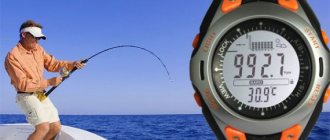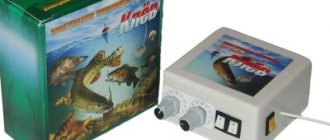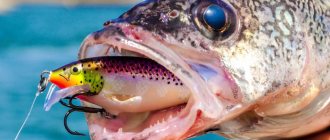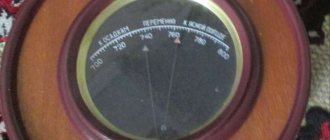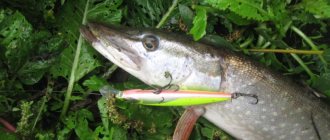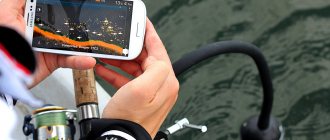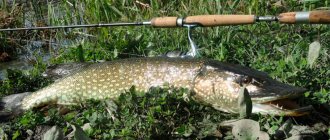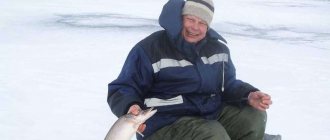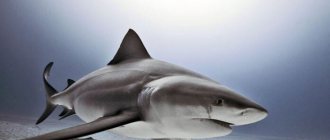Many people say that they go fishing not for fish, but to relax and have fun. But, of course, everyone is pleased to return home with a good catch. Sometimes, upon arrival at a pond in winter, you can find a crazy bite, sometimes the fish bites neither shaky nor weakly or even refuses to take the offered bait. The activity of underwater inhabitants largely depends on pressure . How does it affect the fish bite and how, depending on the pressure, can you choose the best day to go to a pond in winter?
What atmospheric pressure is best for fishing?
One of the biggest troubles when fishing is the lack of bite. Every fisherman wants to know why this happens. If we discard subjective reasons, such as illiterately configured equipment, poor bait play, incorrectly chosen bait, and many others. etc., then natural conditions remain, including pressure.
Atmospheric pressure is the pressure of the atmosphere located above a specific area of the earth's surface. There is an opinion that the optimal pressure for fishing is 760 mmHg, but this is completely incorrect. How many mmHg (hereinafter referred to as Hg) is actually considered normal and leads to an increase in the number of fish bites.
Any piece of land has a different height above sea level, therefore it is different, and this is worth taking into account. So, for the middle zone, the norm is 760 mm, but for Western Siberia the normal pressure is much lower - only 746 mm. The pressure also varies during the day by 1-3 mm, but the fish practically does not react to this.
The fish reacts to its more significant fluctuations.
Table. Fishing information on the influence of barometer values on a favorable outcome in fishing for peaceful and predatory fish.
| 752 | Low pressure. No fish will be caught. |
| 754 | Severely low blood pressure, it is better to wait for it to rise. |
| 756 | Pike and perch can go for spinning baits, but otherwise the bite is weak. |
| 758 | Reduced pressure is suitable for some carp and perch species. |
| 759 | Barely lower values on the barometer signal that predators will be caught well. Ideal atmospheric pressure for fishing in the fall. |
| 760 | Normal pressure – strong bite for most cyprinids (bream, carp, crucian carp, tench, roach). |
| 762 | Both in summer and winter, slightly elevated barometer values do not interfere with normal fish biting. |
| 764 | Ideal pressure for pike. |
| 766 | The fish is on the surface of the water during high pressure; wobblers, sbirulino, and a float are suitable for fishing. |
| 765 | Catfish, burbot, pike perch and other undemanding fish will bite more often than carp species. |
Increased and decreased
Before we talk about how changes in pressure affect the fishing process, let’s briefly look at what atmospheric pressure is, as well as which value is normal, and which is high or low.
Atmospheric pressure is the force with which air (aka the atmosphere) presses on the surface of the earth and the objects on it. Air has its own mass, and therefore has a similar effect. The strong influence from the outside is balanced by the force of pressure inside living organisms.
The normal value with which air affects the surface of the earth is 760 mm Hg . This is equivalent to the fact that the air creates a force of 1.033 kg per 1 cm square of the earth's surface. Any fluctuations in the pressure of air masses mean a change in the force of the air, which is felt by every living organism on the planet.
Naturally, fish are no exception, and therefore it is logical that they change their behavior under low or high pressure. The fisherman, in turn, needs to know the behavior of a particular fish when the pressure changes, otherwise he risks being left without a catch where there was an intense bite yesterday.
Fishing at low and high pressure
Among all weather conditions, it is atm. pressure has the greatest influence on the favorable or negative outcome of fishing. Moreover, pike, perch, catfish, carp and roach react completely differently to lower and higher barometer values.
According to the observations of fishermen, when the pressure drops, predatory fish begin to hunt more actively and it does not matter whether there is wind or not, sunny or cloudy weather, regardless of the time of day and phase of the moon.
Especially if it has dropped, after the weather had been stable with high atmospheric pressure for several days, the predators begin to really eat.
There is a hypothesis that they are trying to get enough before the weather changes, fearing that it will become much more difficult to do so later.
Atmospheric pressure drops with the arrival of a cyclone and rises with an anticyclone. Predatory fish begin to bite poorly several hours before the arrival of the anticyclone.
At high pressure, the predatory fish becomes passive, but during this period the whitefish willingly bites. Without fear of predators, the white fish begins to look for food. White fish activity is observed from the moment the barometer needle begins to creep up and continues throughout the entire stabilization time.
Since with the arrival of the anticyclone, windy and clear days are established, therefore, it is in such weather that it is better to catch white fish. During this period, whitefish bite throughout the daylight hours.
Consequently, it bites best when there are no sharp jumps that cause equally sudden changes in the weather. Remember, if the weather does not change for 3 days, favorable conditions for fishing are created. It is believed that if the temperature and pressure of the atmosphere do not change for 7 days, the fish bite will be ideal.
Optimal atmospheric pressure for fishing
To say what is the best pressure for fishing, you must first decide what you are going to fish. If the goal is to catch a predatory fish, then you need to wait until the barometer starts to fall. See the table for the best values (indicated in mm of mercury, abbreviated as Hg).
| Pike | 758-764 mmHg (there should be no strong jumps) |
| Perch, Pike-perch | 758-762 mmHg (may fall, rise or remain unchanged, but the values should be within the normal range) |
| Bream, bream | 755-760 mmHg (good if the values do not change or increase slightly) |
| Carp, crucian carp, tench | 755-765 mm Hg (comfortable pressure has a wide range, which is why carp fish bite more often than other species) |
| Catfish, burbot | 750-770 mm Hg (no correlation with a suitable pressure value for a good bite) |
| Grayling, Trout | 758-762 mm Hg (pressure does not change, a slight decrease is acceptable) |
The chances of returning with a rich catch are much higher. If you want to catch whitefish, you will have to wait for the arrival of the anticyclone, and with it, sunny days. It is at this time that she takes the bait more actively.
Fishing at high pressure
So, we have long-term high blood pressure.
Three days have already passed, the sun is hot outside, we can go. The fish have adapted to high pressure, but you won't catch many of them in the sun. The bite is best in the morning (especially near the shore on a float), so by 4 am we should already be there. It is white fish that manage to raise the most on such days. Predators do not like high pressure, since all prey on warm days becomes more mobile and “hangs out” mainly in the upper waters, into which pike and other toothy guys rarely try to climb, and if they do, it’s more by inertia, in the heat of the chase. At high rates, predators are sluggish and sullen.
But crucian carp, carp, bream, white bream, grass carp, chub and other “herbivores” from their company bite excellently. At least at first. It is better to fish at pressure 3–7 days after it is established. Prolonged high pressure has a detrimental effect on the bite, but not because of the pressure itself, because of the scorching heat that it brings with it and, as a consequence, because of the lack of oxygen, which is a consequence of rising water temperatures.
During periods of prolonged high atmospheric pressure, bottom gear is best suited for fishing. At depth, far from the shore, there are still plenty of moving specimens. The same is advised for those who want to catch bigger fish. These will have to be caught on a feeder. It can be effective even at lunchtime.
Reasons for changes in fish behavior
If the sense of touch is normal, the fish sees the food perfectly, feels great and there is no need for it to reduce its activity.
The sense of touch of fish is vaguely similar to the principle of operation of an echo sounder.
When moving, the fish creates barely noticeable waves, allowing it to navigate and determine the correct distance to various objects located in the water column.
In addition, thanks to these waves, the fish accurately determines the depth at which it is located.
This works best for surface fish. The fish orients itself and determines the distances to various objects in the thickness of the reservoir according to a specific density. As the pressure rises, the water level drops slightly, causing its density to increase.
At the same depth, the fish begins to feel discomfort and moves higher. Now the waves created by the fish carry information that is unusual for it and it is necessary for some time to pass until it adapts.
After the acclimatization period is completed, the fish feels good closer to the surface of the water, where it is easier to get food. Therefore, the bite of white fish increases as soon as the barometer creeps up.
Influence of atmospheric pressure depending on the season
Spring bite
The most wonderful time for fishing is early spring, when the water temperature begins to rise, hungry predators, and most of the ichthyofauna are actively biting on any bait.
The bite may drop due to gusty winds, a sharp drop in temperature and strong pressure surges.
From mid-April, the fish become more picky and willingly bite in light winds and stable weather throughout the day. She is also reluctant to take bait in cloudy waters, which is associated with melting snow.
Summer bite
In summer, when the water rises to more than 25 degrees, the fish becomes apathetic, and its behavior is highly dependent on atmospheric pressure. Cloudy but windless days are considered optimal weather for fishing. The predator takes bait well on days with short thunderstorms.
It is best to go fishing either at dawn or at night, when the temperature is slightly lower than during the day.
Autumn bite
In the fall, as soon as the temperature drops, the fish begin to actively take the bait. For fishing in the autumn season, it is better to choose warm days with light winds.
Pike bite more actively in September on cloudy days, until the first cold, then the bite drops. But carp breeds have low activity in the fall.
Winter bite
In winter, most fish are very susceptible to pressure fluctuations.
If it has changed up and down several times in a short period of time, you should not expect a good bite, even if it stabilizes. It needs to stay at the same level for 2-5 days, then there will be a bite. Whether there will be a bite or not depends very much on the combination of ambient temperature and pressure. So, if in winter the barometer rises by 25-30 mm, and the thermometer drops by 7-12 degrees, you can’t expect a bite.
Also in winter there will be no bite if it drops by 9-11 mm and at the same time the temperature changes. The bite will resume only when these parameters stabilize.
The bite will be good if high pressure is combined with low air temperature, and low pressure will be on days of thaw and mild frosts.
To decide which pressure is best for fishing, you must first decide what you want to catch and then, depending on the season, choose the optimal days for fishing.
Source
The best wind direction and strength for fishing
Calm weather makes the fish sluggish and inert. Then the breeze is the fisherman’s ally. But how strong should it be to bring maximum benefit when fishing?
In autumn, the wind causing waves will scare away the fish. And the bait at the bottom of the reservoir, fluttering too intensely due to the influence of the wind on the gear, will alert the cautious crucian carp. Therefore, if, looking outside, a fisherman assesses the wind strength as “strong” or “very strong,” then it is better for him to stay at home. But, after the autumn wind calms down, it’s good to go after crucian carp and bream: they really like to pick up delicacies in the coastal waters, washed by the waves from the shoreline.
If the wind causes slight ripples on the pond, start fishing vigorously. The crucian carp are calm, and behind the ripples they can’t really see what’s going on on the shore.
Now let's talk about wind direction . It is a myth that fishermen claim that the bite is good in southern and western wind directions. For the physical condition of the fisherman - yes, for the fish - this does not always mean a good appetite.
A warm autumn wind from the south will give a good bite if the water is cool, and if the wind is cold, then the water should be warm. This relationship between water temperature and wind direction - “warm - cold” or “cold - warm” will be a factor in the fisherman’s luck.
Atmospheric pressure for fishing
Normal atmospheric pressure for humans is considered to be 750 mm. rt. Art. at the zero level. With an increase in relief, for every 10.5 meters the norm decreases by 1 mm. rt. Art. Each region will have its own norm.
Normal atmospheric pressure for fishing is one that does not change by more than 7-8 mm. rt. Art. within three to seven days. Gradually, the fish can adapt to almost any pressure.
The influence of atmospheric pressure for fishing affects primarily the change in water density. As pressure increases, the density of water increases and its level becomes slightly lower. When the pressure decreases, the picture is the opposite. In both cases, the fish is forced to find the water level (depth) at which it will feel comfortable. In this case, the fish goes through a short period of adaptation, during which it stops feeding.
If the barometer mark is between the positions “rain and thunderstorm” or shows excellent weather, you can’t expect a bite.
When the mark on the barometer is in a position between “rain” and “clear”, you can count on an excellent bite.
Large fish react most painfully to changes in atmospheric pressure.
Peculiarities of biting at variable atmospheric pressure
Atmospheric conditions are unstable throughout the day. A sharp change occurs in the summer, when the heat gives way to showers, thunderstorms, and the appearance of strong winds. In addition, daily temperature fluctuations have an impact.
The behavior of individuals also depends on other factors. In summer, the temperature of the water affects more than its change; there are also strong fluctuations. If the conditions in the water are quite comfortable, then, for example, the pike is active regardless of its daily fluctuations.
The water level changes with a sudden change in pressure. If water fluctuations do not exceed 50 cm per day, then the bite will be intense regardless of any changes. But this happens only under one condition - it falls or rises smoothly. Fish react negatively to sudden jumps, a drop of 10-12 points at once.
At what pressure is the bite better?
It is difficult to provide for all conditions. We must come to terms with the fact that there are periods without biting, regardless of the weather. If you wait until all the parameters converge, the gear will decay and the bait will rust.
The result of fishing depends on pressure at any time of the year and not only on its absolute, but also on relative indicators - how it changes in the interval of 1 - 3 days.
If the pressure is stable for several days, you can count on a bite. With the mercury column creeping up, you shouldn’t hope for a big catch.
Before rain, the fish bite better because the pressure slowly decreases and the density of the water increases. This is a signal for the fish: you need to refresh yourself and stock up on energy.
Low atmospheric pressure
- When the pressure is low, it often rains and there is wind. These factors contribute to mixing the water and restoring the oxygen balance in it.
- white fish becomes lethargic, its activity drops sharply. Roach, silver bream, bream, and bleak descend to the lower layers of water, where they become easy prey for active predators.
- as soon as the pressure begins to decrease, bottom fish come to life, especially large predators. The intensification of the bite reaches the point of “zhoring”, especially in the first, transitional hours from high to low pressure;
- even a slight decrease in atmospheric pressure (2-3 mmHg), especially if there was a stable period of high pressure before this, can increase the bite of predators;
- a short-term decrease in pressure during a warm summer thunderstorm can activate the biting of silver bream, roach and bream;
- If there are large, low and dark clouds in the sky, there is a significant decrease in atmospheric pressure, there will not be a good bite for white fish.
Increased atmospheric pressure
- gradually getting used to the increased pressure, fish, especially those capable of feeding near the surface (bream, silver bream, bleak, roach, etc.), begin to actively hunt;
- with increasing pressure, especially after a long period of low pressure, the white fish bite becomes more active;
- gradual increase in pressure and weak gray high clouds guarantee excellent bite;
- during a long period of high pressure and calm, the amount of oxygen in the water sharply decreases, and bottom-dwelling fish suffer from this to a greater extent;
- The activity of bottom fish (catfish, burbot) decreases with increasing pressure. Adaptation to the new pressure is delayed, especially when compared with the speed of activation of white fish;
- The exception is pike perch and perch, which practically do not suffer from pressure changes and can move from a depth of 12 meters to a depth of 3-6 meters.
Optimal pressure for winter fishing
The optimal pressure lies in the reaction of the fish to its decrease or increase. Different species of fish react differently to this phenomenon.
With low pressure, only predatory fish remain active, since it is easier for such species to relieve their hunger during this period. Catfish, pike perch, pike and perch become more active during this period. Catching these fish will be the most effective. All the rest of the fish at this moment will lie on the bottom at rest without signs of activity.
With increased pressure, the activity of predatory fish is muted, and the activity of most other fish increases. Fish, free from predators, begin to swim freely and increasingly rise to the surface to search for food. White fish are the most active. These are crucian carp, young perch, bream, roach.
This kind of activity begins with the first signs of increased pressure and continues throughout the entire time period until the pressure decreases.
It should be understood that this is not acceptable for a sharp increase or decrease in pressure, since with such an outcome any fish stops being active.
Weather changes
A significant role is played by changes in atmospheric pressure for fishing. It bites better in stable weather, regardless of the number of millimeters of mercury. But the climate that influences biting is constantly changing, so we will characterize all its changes.
- Stable normal pressure is best for catching any fish.
- A good bite is also observed when the atmosphere has a high, stable level of air pressure.
- At a stable low level, the bite will be C-grade, but the predator is active.
- As pressure increases, fish become more active.
- When pressure drops, biting is active in all types of fish.
- Jumping weather is marked by a decrease in fish activity and an almost complete lack of biting.
This is interesting: Moose kidneys recipe
Photo 3. Table of the dependence of bite on pressure
Phases of atmospheric pressure changes
- the beginning of a decrease in pressure when a cyclone appears. The weather remains clear and comfortable. Predators feed heavily. Best time to catch them;
- a sharp drop in pressure when a rain front enters the arriving cyclone. Characterized by a good bite from predatory fish. If after a thunderstorm or rain the pressure increases or stabilizes, then the predators’ bite stops. In the event of a continued decrease in atmospheric pressure after rain or thunderstorms, a good bite of predators, especially pike, continues;
- After a shower or rain, a period of stabilization of atmospheric pressure may occur. Characterized by the absence of periods of decrease and increase in pressure. This period can last from several hours to the whole night. Maximum periods of stabilization occur in mid-summer or winter. The fish enters a period of uncertainty. During this dormant period, predators stop feeding. Only single bites can happen if the bait gets under the fish’s nose.
- increase in pressure. Predators stop hunting for active fish and switch to less active food - sick or injured fish, frogs, mice. Rare catches consist of non-trophy specimens. White fish actively feed, and, with increasing temperature and pressure, move to the upper layers of water.
- Stabilized high atmospheric pressure is characterized by a good bite of non-predatory fish and their activity, especially in the morning and evening.
It happens that over the course of several days, the pressure jumps sharply several times a day. During such periods, the bite stops for all fish. She does not have time to adapt to constantly changing conditions, and is forced to give up searching for food.
Atmospheric pressure becomes most important in the life of fish in winter. Cold water becomes densest in winter. It takes a lot of strength for the fish to overcome the resistance of “thick” water. High atmospheric pressure only makes the situation worse.
A smooth decrease in pressure always leads to increased activity and biting. This period continues until the arrival of the next anticyclone.
The nuances of blood pressure changes
It should be taken into account that, even if the optimal atmospheric pressure for fishing, averaged for the area, has been established outside, there is no need to rush. After the blood pressure has been kept at unusually low or high positions for some time, the fish must adapt to it.
But the worst fishing happens when the pressure fluctuates constantly and significantly. For example, today it can rise by 10 points, the sunny weather will last for a couple of days, and the day after tomorrow clouds will appear overnight and it will drizzle for a couple of days. Then again it will be partly cloudy or sunny, then cloudy again. At such moments the fish is in complete prostration. She does not have time to adapt to one conditions before they are replaced by others, and absolutely opposite ones. It is clear that at such a time, regardless of the sun on the street or the rain, she has no time for appetite.
So, despite the fact that the best atmospheric pressure for fishing is the average for the area, you can fish even at a stable low or high level. The best pressure is one that stays at the same level for several days and does not fluctuate twice a day. It is at this pressure that the fish are most active and inclined to take the bait.
Signs of pressure changes
These signs of changes in atmospheric pressure for fishing are significant only for specific areas, since most forecasts from the media provide average data over a wide area, only partially related to a specific fishing location. Signs and observations will help determine what atmospheric pressure is in a given place at a given moment.
To lower pressure
- changes in wind strength and direction, decreased air temperature, increased humidity;
- lack of morning dew;
- change in cloud density. Dense clouds;
- the water becomes viscous and oily in appearance;
- waves form stable foam off the coast;
- bubbles formed by the movement of the boat do not disappear for a long time;
- smoke descending and fog that does not clear during the day;
- warming and cloudy weather in winter;
- bright red morning dawn;
- upper and lower clouds move in different directions;
- the sun sets into dense clouds;
- cirrocumulus clouds appear;
- radio interference;
- swallows and swifts fly low;
- wind increases in the evening;
- inconsistency of signs of changes in atmospheric pressure.
To increase pressure
- sunny and partly cloudy weather;
- gradual weakening of the wind, disappearance of precipitation and cloudiness;
- cumulus clouds, in inclement weather, move in the direction of the wind;
- the appearance of warm air;
- the appearance of gaps in continuous clouds;
- the presence of white and fluffy clouds;
- increasing air transparency;
- the presence of haze on the horizon;
- heavy dew in the morning;
- the fog disappears with the appearance of the sun;
- the sun goes behind the cloudless horizon in the evening;
- a pronounced difference in temperature at night (cold) and during the day (hot);
- swallows fly high;
- in the evening the wind weakens;
- smoke rises up.
Peculiarities of behavior of different fish when pressure changes
There are results of studies and observations of fishermen on the behavioral characteristics of different species of fish and their reactions to changes in pressure.
- Roaches are able to adapt very quickly, much faster than many other fish, to changes in atmospheric pressure by releasing excess air from the swim bladder into the intestines and then out, or by swallowing air from the surface of the water. But in winter, the surface of the water is covered with ice, so the fish are left with only the first option. Accordingly, the roach quickly adapts to the increase in pressure, and after it decreases, it can “sick” for quite a long time.
- In its reaction to changes in atmospheric pressure, bream
- Fans of perch fishing should know that minke whale reacts worse than other fish to a sharp increase in atmospheric pressure. Therefore, during periods when the barometer needle is rapidly rising, you can switch to hunting for other fish if you do not want to completely give up going to the reservoir.
- In some reservoirs, crucian carp bite well all winter . Fans of ice fishing should be aware that this fish cannot quickly regulate the amount of air in its swim bladder. Therefore, it reacts very poorly to sudden changes in atmospheric pressure. In this case, shortly before a sharp drop in pressure, crucian carp can become very active. The fish, sensing the approach of bad weather, strives to eat for future use.
Reasons for changes in fish behavior related to atmospheric pressure
- when atmospheric pressure changes, the density of water and the solubility of gases in water change;
- white fish follow their food into oxygenated layers. With increasing pressure, the upper layers become such layers. In turn, fish also need oxygen for the normal functioning of metabolism;
- the upper layers of water, with a decrease in pressure, first of all lose oxygen, forcing the fish to sink to the bottom;
- During the passage of an area of low pressure, all layers of water are not only mixed under the influence of wind and rain, saturating it with oxygen, but also cooled. This factor is especially significant for fish in hot, windless summers and during the “blooming” of water in stagnant reservoirs;
- Just before a thunderstorm there is a sharp change in pressure. The air becomes heavy and viscous. The swim bladder of the fish sharply narrows and causes numbness, similar in effect to lethargic sleep. After the thunderstorm, the condition of the fish returns to normal;
- the pressure of a fish's air bubble consists of atmospheric pressure and the pressure of the water column above it. With a sharp increase in pressure, the fish is forced to swallow atmospheric air, float to the upper layers of water or go to shallow water to normalize its internal pressure. The most susceptible to this phenomenon, due to the peculiarities of the structure of the air bubble, are roach, bleak, crucian carp, bream, silver bream, carp, carp, etc.
Factors influencing the bite
Natural factors have a particularly strong influence on the success of fishing. These include :
- Water level in a reservoir - changes in water level have a direct impact on the bite. The fish reacts weakly to a slow increase or decrease in the level, but with a sharp change in this parameter, the bite decreases.
- Water clarity - In very clear water, the fish becomes cautious, trying not to catch the eye of a predator, but at the same time, it can clearly see the bait. In very muddy water the bite is reduced or absent.
- Shaded by clouds - clouds do not directly affect the bite, but their presence determines the illumination of the reservoir by sunlight and thus the temperature. In hot summer weather, the fish goes into the depths, and in low light conditions they tend to shallow water.
- Windiness - wind affects the temperature of the water in a reservoir, and waves can form under its influence. Small ripples on the surface of the water prevent the fish from seeing what is happening on the shore, while strong winds reduce the maneuverability of the gear.
- Current speed - The current stimulates the fish to move, it begins to feed intensively, predators hunt, peaceful ones are also actively looking for food.
- The gravity of the atmosphere is one of the main factors. In order to understand at what pressure the fish bite better, you need to know how certain species behave when air pressure decreases and increases.
In addition to the factors listed, success in fishing may depend on the condition of the fishing gear, the correctly selected bait and the behavior of the fisherman himself.
conclusions
After reading this article, some anglers may disagree with its content in that significant changes in atmospheric pressure negatively affect fishing results.
At the same time, objections can be supported by examples from personal experience. For example, the atmospheric pressure dropped - but the fish continued to be caught well. Or vice versa - the barometer jumped - but this did not affect the bite. Let's try to explain why this happens. Changes in atmospheric pressure cannot be considered in isolation from other weather factors.
For example, the pressure has dropped, and it would seem that fish should stop being caught. But a decrease in atmospheric pressure is in many cases associated with rainfall or increased wind. Both wind and rain enrich the water with oxygen, which in turn increases the activity of fish. In addition, rainfall washes various food into the water, and the fish begin to actively feed.
An increase in atmospheric pressure often leads to improved weather conditions: the illumination of water bodies increases, and the temperature of air and water rises. These changes also have a positive effect on the feeding activity of fish.
A few words should be said about winter fishing. In conditions of low temperatures, all life processes of fish are inhibited. Some fish species stop feeding altogether. In winter or late autumn, the influence of atmospheric pressure on fish biting is not as pronounced as in the warm season.
Optimal atmospheric pressure for fishing
For pike
- the best time for biting, in the warm season, is when the pressure gradually decreases (cyclones are approaching);
- in the middle of summer, with almost always high pressure, the bite is worse than at other times of the year. It is better to fish in summer during short-term, morning or evening drops in pressure;
- Even a decrease in atmospheric pressure by 2-4 mm leads to increased biting. rt. Art. after an increase or persistently high atmospheric pressure;
- the lowest point of pressure before increasing is most likely for active biting;
- the period of increased pressure, after the stabilization phase of low pressure, is characterized by indifference to the usual food items. Pike reacts to slower victims - sick fish, frogs, offal, etc.;
- with an increase in pressure and the departure of the main food sources to the upper layers of water, the pike switches to ambush hunting;
- at low pressure avoids shallow water;
- in autumn, cloudy weather with drizzling tedious rain is optimal for pike fishing;
- In winter, pike are most active during periods of low atmospheric pressure, which are commonly called thaws.
For crucian carp
- most dependent on changes in atmospheric pressure. With long-term high blood pressure, especially in summer, it is capable of hibernating and switching to skin respiration. The second behavior option can be considered the rise of schools of crucian carp into the upper layers of water and an almost complete refusal to feed;
- After a long cyclone, the bite is revived by a gradual increase in pressure. It begins to actively manifest itself at the beginning of the anticyclone;
- at normal pressure in the upper layers of water it rarely feeds;
- stable warm weather with low atmospheric pressure (gray days) moves crucian carp to depths, where it continues to feed all day;
- A short-term drop in pressure, such as a summer thunderstorm, can activate the bite. Fishing should be done in deeper and more remote places, mainly with animal bait. This drop in pressure should be preceded by persistent hot weather. Immediately after a thunderstorm, the bite of large crucian carp stops.
For carp
- The most favorable moment for carp fishing is the change of atmospheric fronts. Such a period is the period when a high pressure area approaches to replace a low pressure area;
- As a predominantly bottom-dwelling fish, carp are sensitive to the presence of oxygen in the water. With prolonged high atmospheric pressure, especially in the absence of wind, the flow of oxygen into the lower layers of water is not significant. Low pressure brings wind and rain, which, mixing the water, fill it with oxygen;
- The ideal pressure for carp is below 750 mm. rt. Art. At higher pressure, carp stay in the upper layers of water and at shallow depths. At low pressure it goes to the bottom to depths.
It must be said that the fish bite is most likely influenced not by atmospheric pressure separately, but by the whole complex of weather processes and seasons. Fish are also susceptible to geomagnetic disturbances of the Earth. The precise influence of specific factors of weather change, including atmospheric pressure, on fish biting has not yet been studied by science. The influence of changes in weather processes as a whole has been more or less studied. However, in each body of water, in each area and in relation to each specific fish, everything happens differently. The fisherman is forced to adapt to the fishing conditions.
Stages of Weather Change | Improvement of the Pike perch bite from 8°C to 12°C
Such Factors include water temperature. The most favorable temperature for pike perch is around 8°. At a temperature of 12° this Predator develops a good appetite.
In the summer, during intense heat, Pike perch is practically inactive; it mainly hides in various cool places. Also, calm occurs if the temperature drops below 8°.
In order not to waste time fishing in vain, we recommend that you first measure the water temperature in different parts of the reservoir using a Thermometer.
If you go winter fishing, then remember that the warmest water is located above the bottom surface. Usually its temperature there is 4°C.
If the Wind rises or the Tide begins, which helps to increase the Oxygen content in the water, then the Pike perch also begins to behave more actively.
When the weather changes, especially in Summer, the predator also switches to “Other” mode. After the spawning of pike perch, a strong Zhor comes, i.e. from about the end of June, so during this period you can catch it almost 24 hours a day.
Daytime pike perch bites are most likely between 11 a.m. and 3 p.m.;
The evening bite usually starts from 18:00 to 19:00;
On shallow edges, pike perch feeds from about 21:00 until the morning. The fish move to the deep edges around 5 am, so it is better to catch it before Dawn.
In conclusion
In summer, carp have a good appetite both day and night (moreover, sometimes night bites, given elevated temperatures, are even better than daytime bites). In cold seasons, the best option would be fishing during daylight hours. Some carp anglers even take into account the phases of the moon, since it is believed that when it “grows”, things will go better. However, the most important factors, sometimes immediately influencing the bite, are: pressure, wind and weather changes. And, of course, our valuable experience! Thanks to which, you can plan a good fishing trip or find a solution on how to get out of even the most difficult situations “without losses.”
